 It seems that a certain tradition of interpreting Chalcedon as a factual disavowal of Cyril has existed in the West. In the East, on the contrary, Christian orthodoxy remained quite definitely Cyrillian. Further more, the implications of the Chalcedonian statement about “the preservation of the properties of each nature” were not always fully recognized in the East. For instance, many Byzantine spiritual authors explain such passages as Luke 2:52 (“Jesus progressed in wisdom and maturity”) as some pedagogical tactic on the part of Christ rather than as a real change from ignorance to knowledge, from childhood to human adulthood. For them, Christ’s divinity implied omniscience, and his humanity was modified accordingly. But was it then concretely identical with our humanity? This reluctance to admit human ignorance in Christ may have Hellenistic-Evagrian roots, which equated “ignorance” with “sinfulness,” and may therefore be anthropologically, and not christologically, motivated. Other Byzantine theologians had no difficulty admitting human “ignorance” in Christ. Their opposition to “aphthartodocetism” also indicates a perception – both biblical and Chalcedonian – that Christ’s humanity was, indeed, very similar to ours in every way except sin. Aphthartodocetism (aphthartos, “incorruptible”), a Christian heresy of the 6th century that truly carried Monophysitism (“Christ had but one nature and that divine”) to a new extreme. It was proclaimed by Julian, bishop of Halicarnassus, who asserted that the body of Christ was divine and therefore naturally incorruptible and impassible. Christ, however, was free to will his sufferings and death voluntarily. Severus, patriarch of Antioch, himself a condemned Monophysite, vigorously challenged Julian on the ground that the doctrine of salvation was meaningless unless Christ’s body was truly human. Justinian I, the Byzantine emperor, then proclaimed it a new heresy in an edict of 564 and would have imposed it on the Eastern church but for his death the following year.
It seems that a certain tradition of interpreting Chalcedon as a factual disavowal of Cyril has existed in the West. In the East, on the contrary, Christian orthodoxy remained quite definitely Cyrillian. Further more, the implications of the Chalcedonian statement about “the preservation of the properties of each nature” were not always fully recognized in the East. For instance, many Byzantine spiritual authors explain such passages as Luke 2:52 (“Jesus progressed in wisdom and maturity”) as some pedagogical tactic on the part of Christ rather than as a real change from ignorance to knowledge, from childhood to human adulthood. For them, Christ’s divinity implied omniscience, and his humanity was modified accordingly. But was it then concretely identical with our humanity? This reluctance to admit human ignorance in Christ may have Hellenistic-Evagrian roots, which equated “ignorance” with “sinfulness,” and may therefore be anthropologically, and not christologically, motivated. Other Byzantine theologians had no difficulty admitting human “ignorance” in Christ. Their opposition to “aphthartodocetism” also indicates a perception – both biblical and Chalcedonian – that Christ’s humanity was, indeed, very similar to ours in every way except sin. Aphthartodocetism (aphthartos, “incorruptible”), a Christian heresy of the 6th century that truly carried Monophysitism (“Christ had but one nature and that divine”) to a new extreme. It was proclaimed by Julian, bishop of Halicarnassus, who asserted that the body of Christ was divine and therefore naturally incorruptible and impassible. Christ, however, was free to will his sufferings and death voluntarily. Severus, patriarch of Antioch, himself a condemned Monophysite, vigorously challenged Julian on the ground that the doctrine of salvation was meaningless unless Christ’s body was truly human. Justinian I, the Byzantine emperor, then proclaimed it a new heresy in an edict of 564 and would have imposed it on the Eastern church but for his death the following year.
We see in all of this that the Fathers of the Church truly struggled with coming up with the faith that we now hold about Jesus, namely that He is truly God and truly man. It was not a simple, easy path to find a way to express Who Jesus Is. The various heresies that arose challenged the Church to come up with statements about who She thinks Jesus truly is.
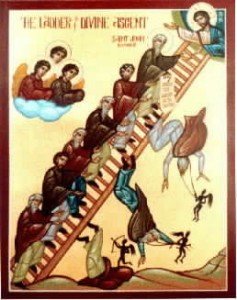 The 28th Step on John’s Ladder, which is PRAYER, can actually be divided into three different kinds of prayer: Spoken Prayer, Mental Prayer and Prayer of the Heart. I have already shared thoughts about Spoken Prayer.
The 28th Step on John’s Ladder, which is PRAYER, can actually be divided into three different kinds of prayer: Spoken Prayer, Mental Prayer and Prayer of the Heart. I have already shared thoughts about Spoken Prayer.
The second form of prayer is mental prayer, or prayer of the mind. This is when prayer goes from being something we do only at certain times of the day to being something we do inwardly throughout the day. Although it is thought of as the next level of prayer, it is something that even beginners can do. We can pray to God silently in our own words in almost any situation. But it takes time and experience in prayer to be able to learn the prayers of the Church by heart. The vast majority of Christians know the Lord’s Prayer, but there are other prayers that Eastern Christians should learn by heart, such as the Trisagion Prayer (i.e., Holy God, Holy Mighty One, Holy Immortal One, have mercy on us) and the Nicene Creed.
The Greek phrase Trisagion translates as “Thrice Holy” – as in this hymn God is described as holy in three different qualities. The hymn is of great antiquity and, perhaps, much older than the event assigned by the Greek Menology as connected to its origin. The tradition recounts that during the reign of Theodosius II (408-450), Constantinople was shaken by a violent earthquake, 24 September, and that while the people, the emperor and the Patriarch Procus (434-446) were praying for heavenly assistance, a child was suddenly lifted into midair, to whom all cried out Kyrie eleison (‘Lord, have mercy’). The child was then seen to descend again to the earth and in a loud voice he exhorted the people to pray: ‘Holy God, Holy Mighty, Holy Immortal’. The emperor then prescribed that it should be introduced into Christian worship. It is one of the oldest prayers of our Church and said at each service.
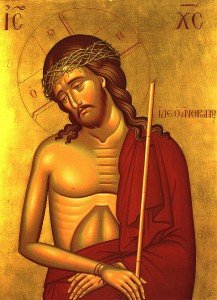 In order to acquire the mind of Christ, we must learn how to embrace the vision He had about human life. This involves our understanding of why God became a human being. It seems that several different versions of Jesus’ vision of life has developed over the centuries and since the separation of the Eastern and Western Churches, we have seen different versions emerge.
In order to acquire the mind of Christ, we must learn how to embrace the vision He had about human life. This involves our understanding of why God became a human being. It seems that several different versions of Jesus’ vision of life has developed over the centuries and since the separation of the Eastern and Western Churches, we have seen different versions emerge.
Anselm of Canterbury’s doctrine of the Atonement (the Western approach) has been said by some to be a key to understanding the rejection of the saving truth of Christianity by an untold number of people in the last millennium. They reject Anselm’s portrait of an angry God who is in need of being appeased; who pronounces people guilty or not. The modern Anselmian doctrine of Atonement reduces the powerfully transformative aspect of the Gospel to a juridical concept, drained of its life. In order to understand the difference between the Churches of the East and West, we must understand something about the approach of Anselm.
One of the greatest miracles for people of ancient times was coming to know the Gospel message: that the True and Living God is Love; a personal and living God Who gave His only Begotten Son, “not to condemn the world but that the world through Him might be saved” (John 3:17). The god’s of ancient times were remote, murderous and even required sacrifices such as children. The concept alone that the Christian God was a personal God of mercy, love and forgiveness, powerfully attracted great numbers. Many even willingly faced the possibility of martyrdom for confessing their faith.
Christ came to bring Life to us, who were dead in Adam, because He Himself is “the Way, the Truth and the Life.” This is the foundation which the first Christians, from St. Paul the Apostle onward, understood as the key to salvation: that “forasmuch then as the children are partakers of flesh and blood, He likewise took part of the same; that through death He might destroy him who had the power of death, that is the devil…abolishing death and bringing life an immortality to light” through the Gospel (Hebrews 2:14; II Timothy 1:10).
I will attempt to contrast the understanding of the Eastern and Western Churches about the meaning of salvation.
More to come!
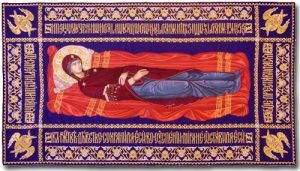 In this article I have been sharing information about the establishment of the major feasts of our Church. I have reached a point where I have been sharing information about the Marian Feasts in our Church. In the last issue I shared information about the feast of the Presentation or the Purification of Mary.
In this article I have been sharing information about the establishment of the major feasts of our Church. I have reached a point where I have been sharing information about the Marian Feasts in our Church. In the last issue I shared information about the feast of the Presentation or the Purification of Mary.
The Dormition is clearly a Marian feast. It marks the “falling asleep” and bodily assumption of the Virgin into heaven. The existence of this wholly Marian feast in the cycle of the twelve becomes intelligible only in the context of the heresies and schismatic doctrines at the time of this feast’s establishment. Contrary to a foremost author, Dix, who sees the Twelve Feasts as a life cycle of Christ, we are totally unable to account for the Dormition and can only explain it as a “sort of afterthought.” The Dormition is an increasingly bold declaration of Marian thought that makes perfect historical sense, however, when one realizes that the Twelve Feasts are not merely a life cycle of Christ but a series of doctrinal statements using Christ’s life and also Mary’s, as the basis of their authority.
The Dormition was first celebrated (c. 450) in Jerusalem under Bishop Juvenal as a feast of the Memory of the Theotokos, on August 15th. According to Karl Holl, Juvenal instituted this feast both to affirm the title Theotokos and to assert his independence from Nestorian Antioch at a time when he was trying to establish Jerusalem as a patriarchate. (I would have my readers note that again it was the Emperor that prescribed that a feast be established. The emperor was the head of the Church at that time).
Although it has not yet been definitely proved, it appears that Juvenal established the feast even before the Council of Chalcedon took place. During the Council, in an act of monumental insincerity, Juvenal, at the last minute, abandoned the Monophysite party he had been supporting for many years in order to join the party that would prevail, namely the True Church. The Dormition’s true pro-Monophysite inplications did not lessen its appeal to the True Church as a weapon against Nestorianism.
As, hopefully, it has become much more apparent from the information that I have been sharing, the Twelve Major Feasts of our Church were really established as a means of reinforcing the True Faith as expressed by the Church through the major Councils of the Church. Each feast reinforces the true faith and, because of the prayers of the feasts, reinforce that faith.
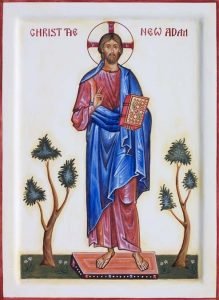 In thinking about what the Fathers of the Church have contributed to our understanding of the Christian faith, it is obvious that error or heresy can often spur one to seek the truth. Heresy has often performed this troubling function in the Church. Surely faulty teaching prodded the Church to understand Christ more clearly, both in His deity and humanity.
In thinking about what the Fathers of the Church have contributed to our understanding of the Christian faith, it is obvious that error or heresy can often spur one to seek the truth. Heresy has often performed this troubling function in the Church. Surely faulty teaching prodded the Church to understand Christ more clearly, both in His deity and humanity.
Exactly what is heresy? Tertullian, writing in the early third century CE, argued that heresy could be identified by its divergence from apostolic teaching and doctrine. He describes a distinct paradigm of revelation and authority. First, Jesus in his earthly ministry “declared what He was, what He had been, what was the Father’s will which He was carrying out, what was the conduct He laid down for humankind: all this He declared either openly to the people, privately to the disciples or through His personal example.
Second, Tertullian explains that Jesus “chose twelve leading ones to be his close companions, appointed as leaders of the nations.” We must always remember that Israel was made-up of twelve tribes. These men proceeded to plant churches through the Mediterranean basin and in doing so “published the same doctrine of the same faith.” While this is true, the doctrine that they planted was not as highly organized and explained as it is now. They preached Jesus Crucified and focused on bringing people to a true relationship with Him. The churches, founded by apostles who had, in turn, been selected by Jesus either directly or indirectly (we must remember that Paul was selected by Jesus through a vision and by connecting him with followers of Jesus) were His authoritative representatives and interpreters, were all part of one connected plant or vine. Indeed, Tertullian contends newer churches “borrowed the shoot of faith and the seeds of doctrine” from those previously planted. It is this sharedseed, of a common apostolic life and doctrine, that identifies a church as “apostolic, as being the offspring of apostolic churches. Every kind of thing must needs be classed with its origin. And so the churches, many and great as they are, are identical with that one primitive Church issuing from the Apostles, for thence they are all derived. So all are primitive and all apostolic, while all are one. One of the signs of the true Church is, of course, apostolic succession – tracing leadership back to the Apostles.
I believe that we are “called to holiness” by God out of love. If we truly respond to this call, we begin to understand that our personal “salvation” is what transpires. So, it would seem that personal salvation is somehow connected to our real and true understanding of the meaning and purpose of this earthly existence. Further I believe that we are challenged to believe that this present life is only a small portion of the immortality which is ours – only a portion of eternal life.
The “call to holiness” requires that we come to a real understanding of the “meaning and purpose of life.” There is truly some reason why we have earthly existence. Our lives are not just some kind of accident and the result of truly undefined purpose.
So the “call to holiness” is a call to wrestle with the meaning and purpose of life. It requires that we attempt to find answers to such questions as: Why is life the way that it is? Why does life include suffering, pain, struggle and disappointment?
The “call to holiness” is actually a call to think seriously about life and not just live life.
To think seriously about life means to make every attempt to come to and true understanding of our personal attitudes and behaviors and what motivates them. To think seriously about life means to make a true assessment of our attitudes and behaviors and determine how they match up to the attitudes and behaviors of Jesus.
Once we seriously think about our life, the “call to holiness” asks us to change/transform our attitudes and behaviors, working to make them more like those of Jesus Christ. Christ, we must always remember, is God’s revelation to us about how we must live in order to truly be His children and to live like He intended human beings to live.
God intended us to live in a certain what for no other reasons than to achieve the fullness of life. To live His way achieves peace and contentment.
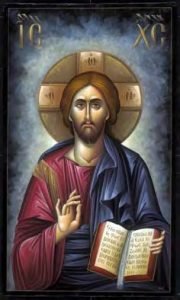 The next important event in the life of Jesus following His birth, was His circumcision and “naming.” This event, in accord with tradition, took place eight days after His birth.
The next important event in the life of Jesus following His birth, was His circumcision and “naming.” This event, in accord with tradition, took place eight days after His birth.
This practice became a law among the Israelites at the time of Abraham. It is a symbol of their covenant with God. For Jewish people this practice is a sign of being a member of the people of God. It means submitting oneself to the law and its duties. Through this act every Jewish male becomes a participant in the blessing and promises God made to His people. It is required for participation in the yearly paschal sacrifice. A man is excommunicated from the Jewish people for non-observance of this law. Since God, in the Person of Jesus, came into the world as a human being in a Jewish community, He embraced this observance.
This feast originated and developed first in the Western Church and later passed over to the Eastern Church. It became a part of the Church calendar to counteract the pagan practices that typically took place on the first day of a New Year.
In the East, the feast seems to have become universal during the eighth and ninth centuries, for at that time, the Byzantine calendars assigned this feast and that of St. Basil the Great to the first of January.
This feast celebrates two events: Jesus’ initiation into the Jewish people and the conferral of His name, which means “savior.” Hence, this feast is also called the “Naming of Jesus Christ.”
This feast is not one of the twelve major feasts of our Church, however. As such it has neither a pre– nor post-feast. It brings to a close, strictly speaking, the post-feast of Christ’s Nativity.
The feast speaks to us of sacrifice and self-denial. There is no genuine service of God without the observance of God’s commandments and the fulfillment of Christian duties. God, in the Person of Jesus, modeled that it is important to make a sincere commitment to living the way God revealed through the Person of Jesus.
The naming of Jesus reminds us of the holiness and power of that name and its great significance. God Himself, through the mediation of an angel speaking to Joseph in a dream, gave this name to Christ.
In the Eastern Church the JESUS PRAYER is a prayer of great power. We are encouraged to call upon God in the name of Jesus.
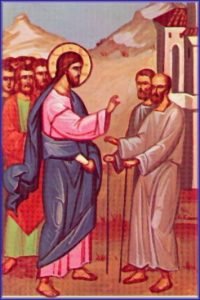 On this fourth weekend of the new year, our first reading are taken from the first letter of St. Paul to Timothy which sets forth Paul’s belief that Christ, Who came into the world to save sinners, dealt with Paul mercifully so that we might know that He will deal mercifully with us.
On this fourth weekend of the new year, our first reading are taken from the first letter of St. Paul to Timothy which sets forth Paul’s belief that Christ, Who came into the world to save sinners, dealt with Paul mercifully so that we might know that He will deal mercifully with us.
Our reading from Luke’s Gospel retells the story of how Jesus cured a blind man near Jericho because the man loudly called to Jesus even though those around Jesus tried to quiet him. Jesus simply asked the man: “What do you want me to do for you?” The blind man replied: “I want to see!” Jesus restored the man’s sight saying: “Receive your sight. Your faith has healed you.”
What message can we derive from these two readings? As I reflected upon them, these thoughts came to me.
So often we humans are blind to the workings of God in our lives. We frequently lack the faith to see that the challenges that life presents to us are uniquely designed to allow us the opportunity to grow in our faith. We fail to see God as a merciful and loving God and think that the difficult challenges in life are either punishments or tests of our faith. In truth the difficulties which all of us must face in life are not punishments or tests. They are opportunities to place our hope and trust in God.
Faith in God is the only thing that can help us understand the true meaning of life and come to see the love extended to us in these challenges. The truth of the matter is that we would never spiritually grow if we weren’t challenged by life. We humans seem to quickly “forget” about our loving God when everything in life is turning out exactly as we want.
Further, the story of the blind man tells us that we have to reach out to God to God for help. The help we must seek, however, is to understand what life’s challenges are attempting to teach us. For some reason when we ask God for help, we desire that He give us what we want and not, necessarily, what we need to grow in our faith and belief in Him.
We get distracted, I think, by the Gospel stories since Jesus usually grants to the people who seek His help, what they want. There are no stories where He refuses to grant what others request. So we grow to think that if we ask He will grant us what we want. He only grants us what is good for us and what we need.
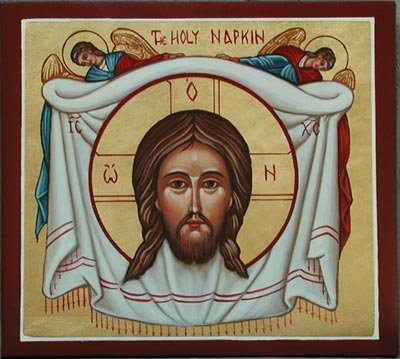 Next week our Church begins its pre-Great Fast sequence of five weeks that deal with various aspects of Metanoia or Repentance. These five weeks are meant to prepare us for the rigors of the Great Fast.
Next week our Church begins its pre-Great Fast sequence of five weeks that deal with various aspects of Metanoia or Repentance. These five weeks are meant to prepare us for the rigors of the Great Fast.
I believe that the icon of the Great Fast is really the icon known as the Achei ropoieta (Medieval Greek): ἀχειροποίητα, that is made without hands. There are several Christian icons which are said to have come into existence in a miraculous manner, not created by a human hands. Invariably these are images of Jesus or the Virgin Mary. The most notable example that is credited by tradition among the faithful is, in the Eastern Church, the Mandylion (icon above), also known as the Image of Edessa or Veronica’s Veil. Supposedly during the Lord’s journey to Golgatha, the woman Veronica wiped His face and His image was left behind. This icon reminds us that we are called to grow in His likeness.
![]() In this article I have been reflecting on the fact that in order to acquire the mind of Christ we must become fully engaged in prayer. The Gospels repeatedly tell us that Jesus went off by Himself to pray. Communication with God through prayer is essential if we are to acquire the mind of Christ.
In this article I have been reflecting on the fact that in order to acquire the mind of Christ we must become fully engaged in prayer. The Gospels repeatedly tell us that Jesus went off by Himself to pray. Communication with God through prayer is essential if we are to acquire the mind of Christ.
In addition to engaging our who selves – mind and body – in prayer, we are encouraged to add reading the Gospel and spiritual books. It is during this time that the heart can become still, lucid, and open to the grace and life which are hidden within the words themselves. Christ tells us that the words He gives to us “are spirit, and they are life.” If we are open and receptive, the Spirit of the Gospel can enter into us, profoundly altering our heart and mind, sanctifying us. Further, not only will we change; through this prayerful encounter we have frequent opportunity for God to speak directly to us in a profound and real way.
Prayer is truly the only bridge over the despondency of the world with its death, sins and passions. It gives light to the mind, helping us to slowly see ourselves as we are, and God as He is. It enables us to overcome temptation and weaknesses. It has the potential to heal our spiritual infirmities. Persistent and patient prayer is the answer to almost all the real questions we have; this is so because it grants us God’s grace and peace. It also brings us to a saving knowledge of the true God, going above and beyond rational thought.
It cannot be stated enough that it is essential to begin again today. Prayer generates prayer. The Fathers tell us that prayer will teach us and be our guide if we are devoted to it. It is the quintessential practice for all Christians. If we say we love God, we pray; if we say that we love each other, we pray for each other. Our life of prayer fulfills the commandment on which hang all the Law and the Prophets: to love God and to love our neighbor. Prayer is simple, but it can be arduous. Prayer is fought against on all sides. It can be our guide and light in all things. Prayer in its highest form, St. Gregory of Sinai says, is God Himself. Let us begin again our conversation with God this very moment, thereby moving forward to our union and salvation in Christ our God.
To acquire the mind of Christ, we must be focused on a relationship with God. The two are inseparable.
